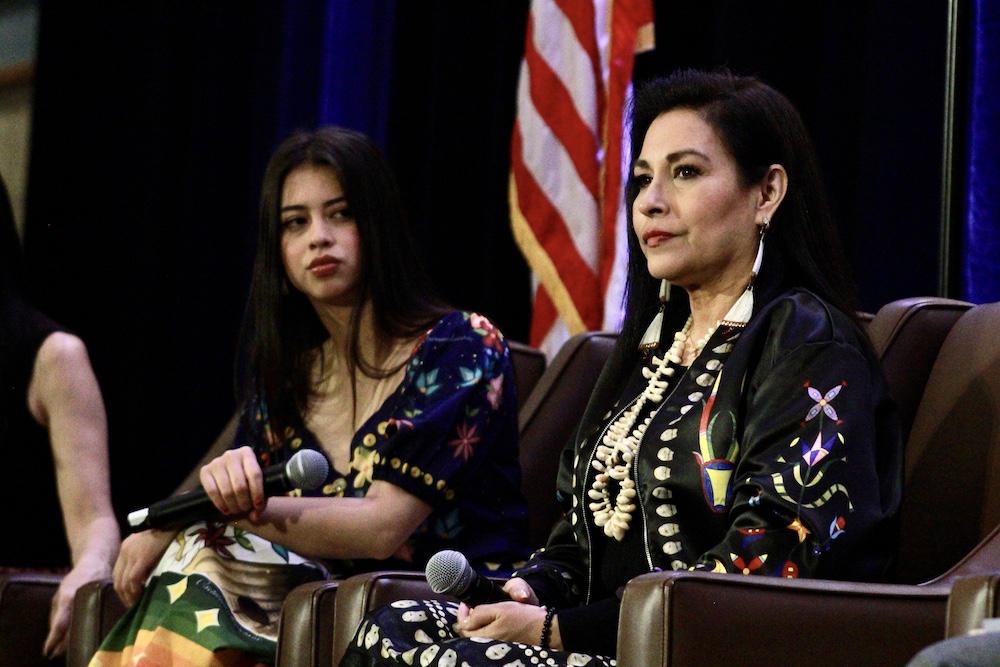
- Details
- By Darren Thompson
TEMPE, Ariz.—United National Indian Tribal Youth (UNITY) hosted its 2023 mid-year conference this weekend, welcoming more than 500 tribal youth leaders from all over the United States.
The conference included workshops, cultural events, empowerment presentations, and keynote presentations by Indigenous film producer and writer Jhane Myers (Comanche), actress Amber Midthunder (Sioux) and casting director Angelique Midthunder.
“500 young people came out and they have brought a lot of attention to their gathering,” UNITY’s Master of Ceremonies Chance Rush told Native News Online. “We’re bouncing back from COVID, and young people are wanting to take control over Indian Country. To do all of that in February is pretty good.”
UNITY was founded in 1976 in Weatherford, Okla. as a national network organization promoting personal development, citizenship, and leadership among Native American youth. The organization’s commitment to promoting Native American youth leadership has facilitated thousands of Native American youth to attend events at the White House, meet cultural and political leaders, and build a network of empowered young Indigenous leaders.
Willie Nelson hosted a benefit concert to raise funds for UNITY in 1980, and in 1985 seven Native youth testified to the U.S. Senate Select Committee on Indian Affairs about issues affecting Indian Country. J.R. Cook, Cherokee, was the organization’s executive director from 1976 to 2013. Mary Kim Titla, a San Carlos Apache citizen and journalist, has been UNITY’s executive director since 2013.
A highlight of the conference was a group discussion about Indigenous representation in the film and tv industry, moderated by Evynn Richardson (Haliwa-Saponi) and featuring Myers, Amber Midthunder and her mother, Angelique Midthunder. Meyers and Amber Midthunder worked together on the 2022 Hulu film “Prey”, the latest installment in the long-running “Predator” film series. Amber and Angelique also crossed paths professionally on the Hulu television series “Reservation Dogs” where Angelique is the casting director.
Amber Midthunder, who played Prey’s main character Naru, shared part of her journey in film with conference attendees.
“I moved to Los Angeles when I was 17, and started auditioning a lot and making sure I poured into myself creatively in every way that I could,” the 25-year old actress told UNITY conference attendees. “That meant a lot of different things. That meant not anyone else just decides for us, especially as a Native person.”
“No one knows our stories better than we do,” Midthunder said. Midthunder is a citizen of the Fort Peck Assiniboine and Sioux Tribe in Montana. She grew up in the southwest, born in Shiprock, New Mexico, and spending much of her upbringing in Santa Fe. Amber’s mother, Angelique, has had a career in casting for film and television for many years.
Myers shared with the conference what influenced her to produce and write films.
“A long time ago, I used to go watch films with my grandparents,” Myers told attendees at the conference on Saturday. “We would pick movies that would have Native content and I remember every time we left the theater my grandfather would mention how he wished at least one time the movies would get one thing right about our people.”
Myers is a citizen of the Comanche Nation of Oklahoma, and has been producing films from documentaries to short films. One thing she hasn’t completely done, yet, is an animation. That will soon change, though.
“I have an animation coming out in the future with Taboo,” Myers announced at the conference. Taboo is a member of the award-winning group The Black Eyed Peas and has Shoshone and Hopi heritage on the maternal side of his family.
Myers recently made history as the first Native American woman nominated for a Producers Guild of America award.
To learn more about UNITY and its organization, visit their website at unityinc.org. Their annual conference takes place June 30 through July 4, 2023 in Washington, D.C.
More Stories Like This
Chickasaw Holiday Art Market Returns to Sulphur on Dec. 6Center for Native Futures Hosts Third Mound Summit on Contemporary Native Arts
Filmmakers Defend ‘You’re No Indian’ After Demand to Halt Screenings
A Native American Heritage Month Playlist You Can Listen to All Year Long
11 Native Actors You Should Know
Help us defend tribal sovereignty.
At Native News Online, our mission is rooted in telling the stories that strengthen sovereignty and uplift Indigenous voices — not just at year’s end, but every single day.
Because of your generosity last year, we were able to keep our reporters on the ground in tribal communities, at national gatherings and in the halls of Congress — covering the issues that matter most to Indian Country: sovereignty, culture, education, health and economic opportunity.
That support sustained us through a tough year in 2025. Now, as we look to the year ahead, we need your help right now to ensure warrior journalism remains strong — reporting that defends tribal sovereignty, amplifies Native truth, and holds power accountable.
 The stakes couldn't be higher. Your support keeps Native voices heard, Native stories told and Native sovereignty defended.
The stakes couldn't be higher. Your support keeps Native voices heard, Native stories told and Native sovereignty defended.
Stand with Warrior Journalism today.
Levi Rickert (Potawatomi), Editor & Publisher

